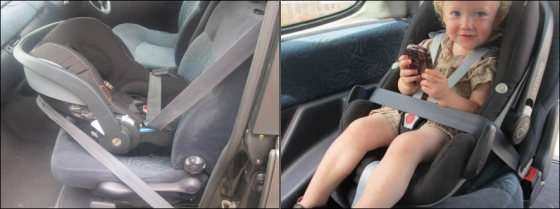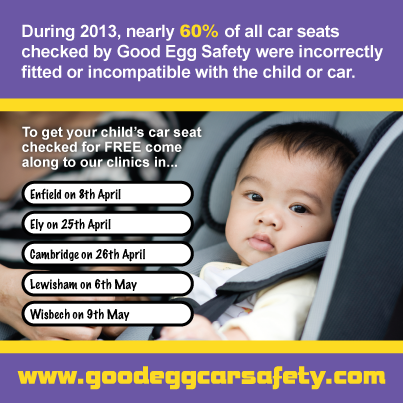And 99% of parents thinks they are correctly fitted!
According to Good Egg Safety, on a national level, 6 out of 10 car seats are installed incorrectly! That is scary!
“Figures released by Good Egg Safety indicate a 13% rise in badly fitted child car seats in the four-year period 2010-2013.
The figures – which are based on more than 10,500 tests conducted by Good Egg across England, Scotland and Wales – show a rise in unsafe fitting
from 47% in 2010, to 55% in 2011, 57% in 2012 and 60% in 2013.” – Road Safety GB <<Article>>
That they are installed incorrectly doesn’t just mean that they look like this:
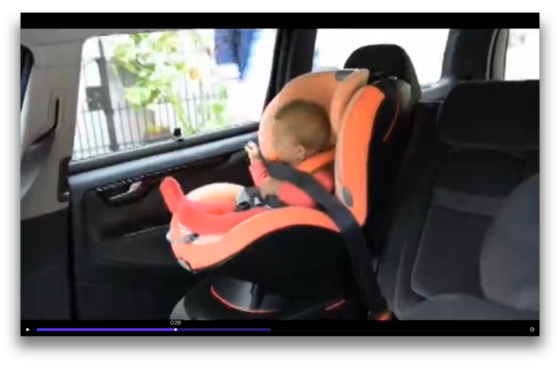
The car seat is not even installed. The seatbelt has just been strapped across the car seat and baby, and buckled in. A fatality waiting to happen!
It can be something “small” that we might not even think that much about, like this:

Straps are so loose that in the event of any impact, the child is most likely going to be sent flying out of the seat. Straps need to be nice and snug!
What can happen if the straps aren’t tight enough? This crash test video will show you (below):
Another lethal error that is seen are these:
The picture on the left shows the shoulder belt threaded in the path of where the lap belt should go, and the lap belt is going behind the seat through the path of what should be the shoulder belt. The picture on the right shows the the car seat forward facing.
The baby car seat we buy is a Group 0+ seat. They can only be installed rear facing! There are no “faces both ways” in this group of car seats! If the baby’s car seat is installed like this, this is what is going to happen (video below):
This crash test video shows us what an impact at 64km/h looks like if the car seat is installed incorrectly, like the two photos above. It’s not a pretty sight is it? Personally I find it a little hard to watch. 😦
Some errors are all most invisible to the naked eye..
- Foot-prop:

Always remember to make sure the green light is either “glowing” or “showing” clearly! This indicates that the foot-prop is correctly installed on the ground.
The foot prop should always have the green indicator showing clearly when snapped in place. If it doesn’t have any indicators make sure it’s firmly placed on the ground and in the correct angle according to your car seat manual.
- Harness postiion:
When the car seat is installed in the forward facing position, the correct placement of the harness is at or above the child’s shoulders. Not below, like Henry is demonstrating in this picture. This is very important because when the child is forward facing during a frontal collision, the crash forces will cause the child’s body to be thrown forward. The harness straps should be positioned at or above the child’s shoulders when forward facing to most effectively decrease the amount of distance the child will travel when propelled forward and to limit the forces on the child’s spine and shoulders.
Crash test video example of wrongly positioned harness:
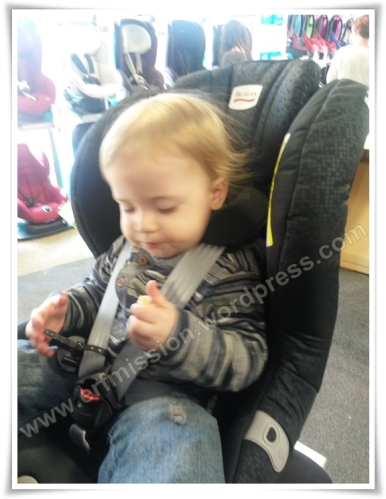
Britax Max Way is a rear facing car seat. Headrest is pulled to the top, making the straps go far above the child’s shoulders.
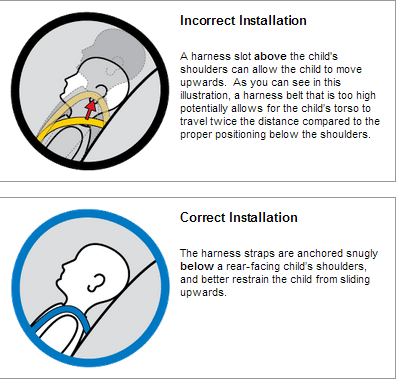
Photo credit: http://www.orbitbaby.com
During a frontal crash, the most common type of collision, the crash forces will cause a rear facing child’s body to ride up the seat shell back. The harness straps should be positioned at or below the child’s shoulders to firmly hold the child down in the car seat. If the harness straps are above the child’s shoulders when rear facing, the child would continue to ride up the seat back and potentially expose their head above the car seat shell, leaving their head vulnerable to injury. This is particularly important in infant car seats (Group 0/0+)!
- Isofix:
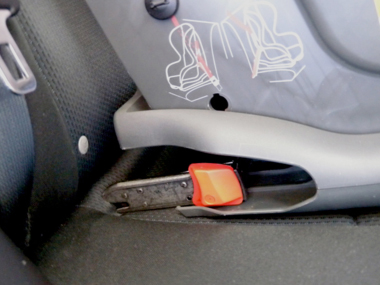
Isofix.
Photo credit: http://bit.ly/1eBKDCZ
Even with ISOFIX seats, you can get a bad install. Here only one of the ISOFIX connectors are properly plugged in. This can easily happen, so make sure to check that the connectors are green and good to go! 🙂
- Buckle crunch:
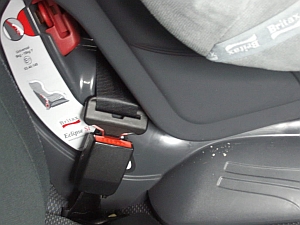
Buckle crunch!
Photo credit: http://bit.ly/1hDlVIr
Not all car seats fit in all cars. A common problem is ‘buckle crunch’. If your car seat has this, it’s not compatible with either your car, or that position in the car. Some seats offer more then one belt path and some cars have different belt buckles depending on where in the car you are. Always make sure you watch out for this! 🙂
- Belt path:
Crash test video of wrong belt path install:
The car seat has red for forward facing belt path, and blue for rear facing belt path. This is universal on all car seats. Make sure you read your car seat manual fully and properly while installing your car seat! 🙂
* * *
I hope this post has been informative! 🙂 ❤
For my post dedicated to the harness and how to keep your child safe in the car seat during colder times, please go HERE!
Q:// Did you learn something new? Did you find this post informative?
Let me know in a comment below what type of errors you have come across! 🙂

